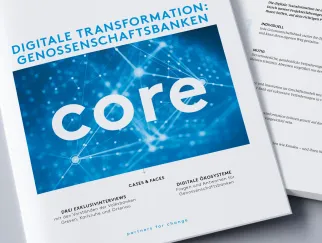Bankers home alone

Alone, at home, and connected digitally: how is the financial sector working during the pandemic?
We interviewed employees of various institutions, and the results are clear: alone, but not without support, and customer confidence is still intact.
In times of crisis, the following applies: only through a reliable and transparent exchange of information can the contact between management and team, but also between the individual team members, remain alive. This in turn is necessary to maintain the productivity and motivation of the employees. Our survey shows that the exchange of information has been quite successful in banks and insurance companies: 70 percent of the respondents felt sufficiently informed from the beginning of the crisis. The remaining participants argued that their employer either reacted relatively late with communication measures or provided too little information.
A neuralgic point: four out of ten participants reported a lack of subconscious communication, which was either not done at all or only insufficiently in virtual voting. These respondents agree that certain topics, such as appraisal interviews, are better handled in person. In addition, personal communication is neglected, for example due to the lack of impromptu meetings in the office “at the watercooler”. Virtual voting, especially in groups, and current processes in the company that are not geared to fully digital processing are also challenging.
Home, sweet home?
A similarly solid assessment was given for work from home: more than 70 percent of the participants stated that they work entirely from home, and around 15 percent also work partly from their home office. The majority also confirmed that they were already productive immediately after the short-term relocation of the workplace. The feedback regarding work productivity in times of Corona also fits in with this. The participants stated that they were able to achieve approx. 87% of productivity compared to before. This is a surprisingly high value for an industry in which working in a home office has been anything but a matter of course. This shows that IT investments in virtual working—”Workplace of the Future”—are bearing fruit. They not only serve to increase employee satisfaction and improve work processes, but are also a fundamental part of emergency management.
Collaboration instead of isolation
More than 60 percent of those surveyed confirmed that teamwork functions surprisingly well. This is particularly true for employees of large and specialist banks. And one in seven respondents even rated their current cooperation as significantly more efficient than before the pandemic. A further 19 percent said that they did not notice any difference. Nevertheless, the familiar problems with remote collaboration cannot be hidden : for example, 16 percent of those surveyed reported that information is lost, and another 14 confirmed that teamwork is difficult. Insufficient working structures and the lack of feedback were also explicitly mentioned. Financial service providers are therefore well advised to optimize these points for virtual teamwork. This includes, for example, clear processes and structures for the information chain and feedback. One example was establishing virtual daily stand-up meetings for this purpose.
Remote leadership long term
A good half of those surveyed say that they work as managers. Of these, 54 percent stated that management works as before, while 42 percent reported limited management. Only three percent conceded that team management no longer functions. Overall, the effectiveness of the leadership compared to before the coronavirus was rated at 80 percent on average. This confirms that there are currently still limitations in leadership behavior while the basic mood is positive. Despite the crisis, banks should use the coming months to continue to work on their digital processes and the associated infrastructure and to further improve the value in the medium term.
Customer confidence is strong
In addition to the changed working conditions, the current situation also has an impact on customer behavior. Increased interactions can be observed across customer segments—especially in regional banks. Among retail customers, for example, a significant increase in requests for short-term liquidity increases can be observed: around 45 percent of participants report increased interest in overdraft increases, 29 percent of inquiries about mortgage financing such as deferrals, and another 25 percent have noted increased demand for consumer loans. It is also striking that almost a third of the banks report increased cash withdrawals.
In the private banking sector, 57 percent of enquiries concerning the restructuring of securities accounts are the most frequently mentioned, but there is also an increased demand for own online access to securities accounts. Corporate banking currently has two main areas of focus, each of which was mentioned by over 60 percent of those surveyed: firstly, KfW loans promoted by politicians are requested, and secondly, the focus is on facilitating liquidity for existing financing, for example by means of deferrals. This shows that customers across all banking segments trust their institutions even in times of crisis and are approaching their advisors to solve problems. This effect is most noticeable at the regional banks on site.
Free interactive analysis of the entire survey
How do employees assess their employers and their managers in the crisis? With our new service offering—the Digital Services Hub—you can analyze the entire survey yourself in an interactive dashboard.
 en
en














